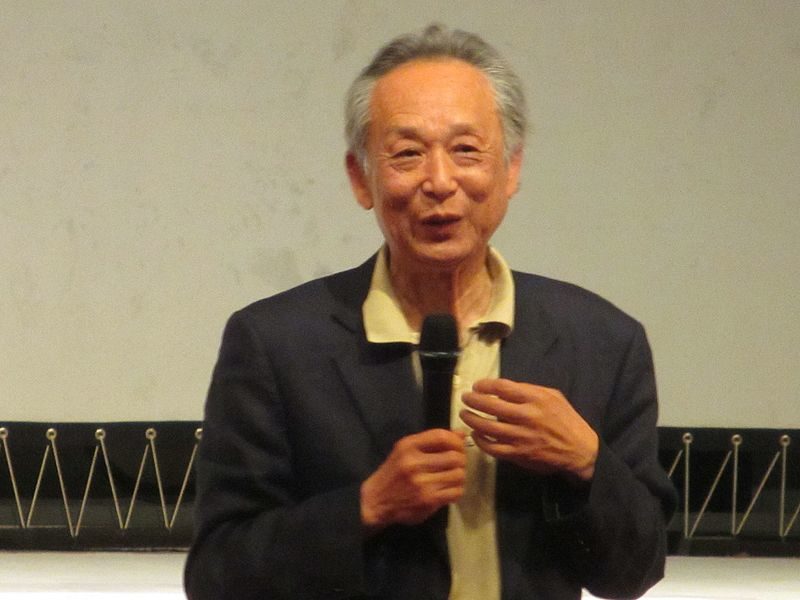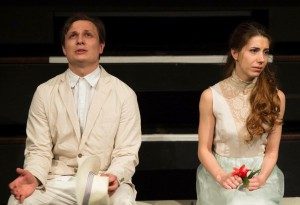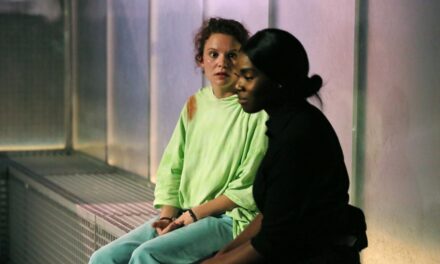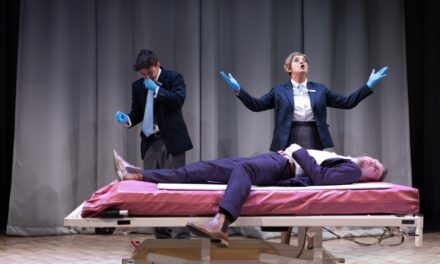The place of dramatic tragedy in the twentieth century was one of extreme ambiguity and elusiveness. While some critics declared it dead or terminally ill, others struggled to critically reconfigure its essence vis-à-vis the transformations of modernity. During the interwar and wartime periods, notable playwrights such as Jean-Paul Sartre, Albert Camus, Jean Anouilh, Jean Cocteau and others sought to recreate the atmosphere of ancient tragedy through adaptations and modern rewritings. A decade after the end of WW2, Camus pronounced the postwar period as “a tragic age” and acknowledged the presence—in France and other parts of the world—of a cohort of writers who were working to “provide our times with its tragedy.” Although he did not mention any names in particular, he was indubitably alluding to the emergence of a new, trans-European theatrical style which, a few years later, critic Martin Esslin would baptize as the Theatre of the Absurd and which several scholars have indicated as a new form of tragedy. While resonating with the principles of Existentialist philosophy, absurdist drama was essentially a cluster of various experimentalist trends, a new avant-garde which aimed to subvert the traditional categories of theatre to reflect the feeling of distress, distrust, and disorientation arising from the post-atomic age. Still, despite the Absurdists’ general concern with various forms of the human predicament, there was no self-proclaimed intent to achieve tragedy as it had been the case with their predecessors. On the other hand, the Theatre of the Absurd does carry elements of tragedy, and much of its dramatic force indeed resides in “achieving the tragic out of comedy,” as Friedrich Durrenmatt once suggested.
In a similar way to the dramatists of the Absurd, who produced works in which tragedy is present as a latent potential, the Sino-French experimentalist playwright Gao Xingjian (1940-), who, incidentally, played a major role in introducing the Theatre of the Absurd in post-Maoist China, penned a series of plays which can be considered as tragedies in disguise.
The first Chinese-language Nobel Laureate ever, Gao Xingjian is an eclectic author and artist, whose entire oeuvre spans fiction, theatre, essay writing, filmmaking, and painting. His degree in French language and literature initially earned him a job as a translator; however, his passion for playwrighting, which he had cultivated since his undergraduate years, led him to become a full-time playwright in the early 80s. While working at the Beijing People’s Art Theatre, Gao wrote four plays (Alarm Signal, Bus Stop, Wild Man and The Other Shore—which was never officially staged due to a ban) and pursued his ambition to give birth to a “modern Eastern drama,” i.e. a form of intercultural theatre based on a blend of Western avant-garde and elements of traditional Chinese theatre.
To escape the stranglehold of governmental censorship, in 1987 Gao went into self-exile to Europe, eventually relocating to France where he continued writing and staging new plays and where he currently lives. As he explained in his Nobel Lecture (Dec. 2000), the key to understanding his artistic work is its transcultural vocation—the ability to transcend the confines of his nationality and cultural background in order to reach out to a worldwide audience. His search for a personalized theatrical language, aesthetically hybrid and intrinsically polyphonic, is tailored to the dramatization of the big questions of meaning affecting the universal man and which feature prominently in his post-exile repertoire. Existence, the self, human language and gender relationships are only a few of the themes he touches upon across his numerous works. Furthermore, his tendency to combine words and images, performance and dialogue, and to model the latter on polyphonic musical genres (e.g. the fugue), far from being a form of experimentalism for experimentalism’s sake, rather testifies to his conception of theatre as a “total,” “omnipotent” art. This, he learned not only from the traditional theatre of China but also from his twentieth-century European masters (particularly Pirandello, Brecht, Beckett, Artaud, and Grotowski), whose works he studied in his youth. Therefore, reading Gao’s plays (most of which are now available in English translation) is a great opportunity to get acquainted with a piece of contemporary world theatre and—partly—to learn about the challenges faced by the Chinese society of the post-Mao era. Furthermore, re-reading Gao Xingjian as a tragic playwright is useful for a better understanding of his existentialist turn, which became increasingly evident after his exile.
Below, I will illustrate what I think are the tragic aspects of Gao Xingjian’s post-exile dramaturgy with a view of demonstrating his subconscious creation of an innovative form of tragic drama, which I have baptized “thirdspace tragedy.”
Gao Xingjian’s “Thirdspace” Tragedies: The Tragic mode and the Tragic Field
Throughout his early exile years (i.e. the late 80s-90s), Gao developed a dramaturgical system with tragic characteristics. This, however, is not tied to a pre-determined classic plot or narrative but is more akin to a dramatic mechanism embedded in the ritual theatre of antiquity yet strongly resonating with the vision of modernity.
Aside from its multiple aesthetic features, Gao Xingjian’s theatre has had at its core the exploration of the individual and his destiny, the challenges and anguishes of the human condition, and the question of the self as a source of both pleasure and malaise. Particularly his post-1987 work, which was written outside of China and bears little contextual reference to his home country, has been deeply shaped by these existential concerns, which, by their own nature, open up the possibility for a new examination through the lens of tragic theory. Gao himself has often pointed out his special interest in representing “modern man’s predicament” and which I regard as the fil rouge tying together the various aspects of his tragic dramaturgy.
Transcending Sartre, who famously argued that “hell is other people,” for Gao what is to be feared is the self with its seductive yet deceptive powers. Concurrently beautiful and terrible, the self is the realm of contradictory forces that strangles the individual from within, like a Trojan horse; the individual’s lifelong and ultimately vain struggle to keep it at bay is the predicament mentioned by Gao as well as the overarching theme of his characters’ shared tests and trials. Gao successfully represents this paradox—which he sees as the lesson of Greek tragedy—through his technique of shifting pronouns (renchen de zhuanhuan), which has its origins in a mixture of Brecht’s epic drama and Chinese folk-theatre practices, and which consists in having the character speak in the third or second person. As further detailed below, it is this potential difference, this chasm between searching for the self and running away from it that engenders a tragic mechanism.
Drawing on William Storm’s theory of tragedy “after Dionysus” (1998), I consider Gao’s tendency to present his characters as mentally riven, almost schizophrenic, as a form of “tragic mode.” Rather than leading to a state of quiet psychological distance from themselves, the adoption of an estranged point of view exacerbates their desire to control their own (and others’) subjectivity. This obsessive thought turns out to be emotionally draining, for it ends up destroying them and marring their interpersonal relationships. The mode through which they manage their own self places them in a tragic situation because it is concomitantly cohesive and divisive. Their psychological dilemma shows that they are prey to an incontrollable endogenous force, the same that Euripides, in his tragedy The Bacchae, personified through the god Dionysus whose specialty is called sparagmos—a form of sacrificial ritual which consists of death by dismemberment—and his “madwomen,” called maenads, who both love and kill. The dynamism through which the self is irremediably torn to pieces with no possibility of recomposition are collectively termed by Storm as a “tragic field” for its analogies to a magnetic field engendered by opposite polarities.
Gao’s characters, already torn asunder by default, soon enter a similar circuit of opposite energies which precipitates them towards this sort of mental and sometimes even physical fragmentation, a tragic mechanism which the examples below will illustrate.
In the dramatic monologue Between Life And Death (Shengsijie; Au Bord De La Vie 1991), a woman speaking in the third person displays a schizophrenic attitude towards her lover whom she both loathes and cares for. In a maenad-like manner, she first kills him, then subsequently feels horrified at her own act of violence and questions the existence of her very own self, which she no longer recognizes as such. This initial situation prompts her to undertake a metaphoric journey into her own psyche, which slowly turns into multiple nightmares, a bottomless abyss which engulfs her body and soul. The play ends with the woman’s body disappearing under a bunch of abandoned clothes, to signify her complete disintegration.
In the play Nocturnal Wanderer (Yeyoushen; Le Somnambule 1994), a traveler sitting in a train carriage with four other people, all strangers to each other, dreams of a night city in which he can live under no social or moral constraints, giving free rein to his impulses in an attempt to “acquire supreme freedom.” A voice accompanies the traveler in his sleepwalking, guiding his descent into an underworld of darkness, immorality, and crime, one which will uncover the vicious side of his own self, thereby effecting the protagonist’s process of tragic de-formation. After (perhaps inadvertently) killing a prostitute and strangling an old tramp, the sleepwalker succumbs at the hands of a masked man, arguably a materialization of the traveler’s repressed devilish instincts.
Dialogue And Rebuttal (Duihua Yu Fanjie; Dialoguer-Interloquer 1993) consists of two parallel performances linked by a mechanism of cohesion and division. On the one hand, there are a man and a girl who, after a one-night encounter, enact a verbal—and later physical—fight aimed at dominating each other by transgressing each other’s psychic borders. On the other, there is a Buddhist monk who struggles to make an egg stand on a stick. Despite the apparent estrangement between the two situations, for the couple seems to be unaware of the monk’s presence and vice versa, a subtle analogy binds the two worlds together: the acquisition of a tragic consciousness, that is, an awareness that reality is pervaded by a fundamental wound, and that unity is a mental illusion. While the monk resolves to crack the egg to achieve his objective, man and girl engage in a last and more vehement exchange of words, in which verbal language is frenziedly dissected, reduced to a bunch of fragments and revealed for what it actually is, namely a(n) (all too) human tool for unifying reality, for hiding the “crack line” that saturates the universe.
My final example of a tragic play, The Death Collector (Kouwen Siwang; Le Quêteur De La Mort 2003), portrays an old man’s neurotic path towards emotional disaster and doom. After he is accidentally locked into a contemporary art museum, the protagonist becomes trapped within a whirlwind of obsessive thoughts and dark fantasies, which then gives birth to an embodied doppelganger. Acting as a malicious instigator, the latter gradually lures the protagonist into believing that his life has come to an end and that suicide is “the only solution.” With its devious quality and sinister vibe, the dialogue between the old man and his double strikingly resembles the agon between Pentheus and Dionysus in The Bacchae. The tragic mode here manifests itself through a mechanism of intermingling subjectivities, which determines the agony of the hyper-divided self, as both the old man and the doppelganger talk in the second person while their individual lines mutually crisscross and the dramatic tension builds to a crescendo until the climactic end.
All these examples show that, in Gao’s theatre, tragedy, rather than a set of elements or a philosophical theory, is an ongoing and (mostly) subtextual dynamism based on an interplay of cohesive and divisive moments occurring in the realm of the psyche. My application of the tragic field theory to Gao’s post-1987 plays ties into his conception of the theatrical space as a “psychological field” (xinli chang), in which the actors’ movements, voices, and patterns of interaction generate a subtle network of interflowing (and ultimately dismantling) energies. The earliest manifestation of this tragic field can be found in the 1986 play The Other Shore (Bi’an; L’autre rive), which was originally created to serve as an exercise for actors and whose content is comprised of several, loosely tied episodic scenes. Prefiguring the dark tone of the post-1987 works, the other shore of the play resembles a Tartarus, a world of shadows which are hungry for the self of others. Dominated by a mechanism of cohesion and division, congregation, and fragmentation, the other shore is populated by a madding crowd of anonymous beings and by individual characters, some of which have decidedly Dionysian features. The unifying element is a male actor, simply referred to as Man, who navigates this realm of indistinctiveness and primordial chaos with the sole intent of searching for himself. Swinging between the two poles of self-affirmation and self-estrangement, throughout his journey Man would go through a range of traumatic experiences, including the temporary loss of self. Similar to Oedipus, who discovers his own true self only at the end of the eponymous play, in the last scene of The Other Shore, the Gaoian Man splits up into two: himself and his heart (aka Shadow), in what proves to be a beneficial sparagmos. Going to the other shore, for Gao, means therefore to enter a tragic field, to experience death and rebirth in the Dionysian way, and to transit from a condition of self-centeredness (and blindness) to one of self-consciousness.
This painful process leading to tragic cognition is what all of Gao’s characters go through in the post-1987 plays I have discussed, for “the other shore” is a constitutive element of Gao’s tragic dramaturgy. However, one major difference between the play The Other Shore and the subsequent plays is that in the latter, the characters start off where the previous (Man) ends and the descent into the abyss is irreversible, though no less enlightening.
Gao Xingjian’s Only Self-Acknowledged Tragedy: Escape (Taowang; La Fuite 1990)
Earlier than the plays mentioned above, Gao wrote one which he subtitled as a “modern tragedy.” The play, titled Escape, was composed in the aftermath of the 1989 Tiananmen Square incident and tells about three anonymous people—a young man, a girl and a middle-aged writer—who find themselves sheltering in a dark and abandoned warehouse after fleeing a massacre carried out by the army at a nameless square. During the play, they pour out their fears, dreams, desires, and disillusions; their mutual interactions are punctuated by harsh verbal confrontations in which they bluntly expose each other’s faults, turning the warehouse—from which they cannot escape—from a safe refuge to a hell-on-earth. As I have argued elsewhere, the dramatic situation of Escape bears considerable affinities to Sartre’s 1944 piece No Exit (Huis Clos), which features three characters trapped in an elegant living room symbolizing an unconventional kind of hell, one very far from the Dantesque representation thereof but not less harrowing.
At first sight, Escape seems to follow the neoclassical unities based on Aristotle’s Poetics. In reality, its tragic potential stems from a much more complex dramatic system. Although the characters are not split up by default, as the technique of shifting pronouns is not used here, they too are affected by the same Dionysian mechanism of cohesion and division, whereby not only is their sense of identity steadily crushed but they also eventually acquire a new self-knowledge.
Here, Georges Bataille’s theory of the “tragic community” may illustrate the cohesive side of the tragic mechanism. Unlike what is happening at the Square (offstage), where there are people killing (the soldiers) and others being killed (the demonstrators), there is no substantial difference among the three occupants of the warehouse: each of them attacks the other and is attacked with exactly the same vehemence. They all share the same plight and no one can rise above the other; all are at the same time both torturers and victims and that is the real meaning of tragedy, which Bataille equals not with death but with existence.
The divisive aspect becomes very evident throughout the numerous agonistic dialogues. The two men debate their opposite views about political engagement: the battle of words is between the young man’s youthful idealism and the older man’s cynicism. The woman is often the object of the men’s desire for possession and objectification. Yet, she is the one who eventually unmasks the darker side of their personality, their inner “dirt.” Though she could use her intelligence to dominate both, the extreme situation prevents her from doing so, and she ends up patiently awaiting her destiny in the company of her fellow-prisoners.
Overall, Escape is a play which utilizes fragments of classical tragedy but whose tragic force lies mainly in the dramatic subtext, for a Dionysian vigor pervades the characters’ mode of interaction, leading to a subtler form of sparagmos, namely the process of psychological dismembering that each character inflicts upon and receives from the others, plus the awareness that in the other’s negative cutting words they can see a double, a mirror-image of themselves. The veiled references to the political event of Tiananmen Square are therefore only a pretext to shift the discussion towards other themes, most importantly the tyrannizing power of the self-as-ego as opposed to the threat coming from the will of others. While one can flee from the latter—Gao argues—the former is inescapable.
In the above, I have reframed a selection of Gao Xingian’s post-1987 plays as “thirdspace tragedies” because their tragic latency is based not on a set of individual elements (of the like of those enumerated by Aristotle or Karl Jaspers), but on a pervasive, fluid dramatic mechanism affecting the psychological universe of the characters. Such a mechanism echoes the Dionysian sparagmos ritual, for it brings about the dismembering of the character’s psyche, which falls prey to obsessions, nightmares, and hallucinations. Furthermore, such mechanism does include two phases of the classic tragic formula, namely the “reversal” (peripeteia) and the “discovery” (anagnorisis). For Gao’s tragic characters, the reversal concerns the self as an intimate-refuge-turned-to-hell, whereas the discovery has to do with the consciousness of reality as irrational and fundamentally broken. This idea not only aligns him with the great masters of world tragedy but also shows the adaptability and continuing relevance of the dramatic mechanisms of ancient tragedy.
Note: This essay is based on the author’s PhD dissertation entitled Dionysus On The Other Shore: Framing Gao Xingjian’s Theatre Of The Tragic (SOAS 2016) currently being considered for publication. One article summarizing the main findings was published in 2017 in Neohelicon and can be found here. One further monographic article on Escape is due to appear in Modern Drama in 2019.
This post was written by the author in their personal capacity.The opinions expressed in this article are the author’s own and do not reflect the view of The Theatre Times, their staff or collaborators.
This post was written by Letizia Fusini.
The views expressed here belong to the author and do not necessarily reflect our views and opinions.


















